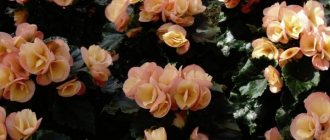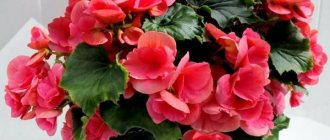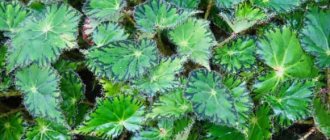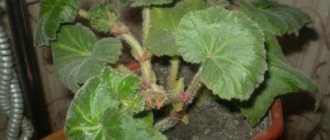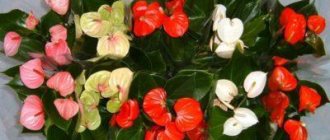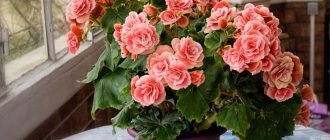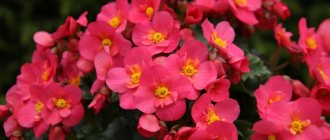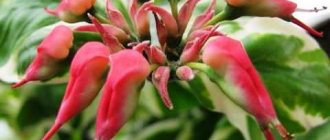Photo
Features of cultivation
Elatior is a delicate, beautiful, easy-to-care plant with abundant flowering, which is why it is often used to decorate home interiors, private homes, and offices.
The following plants are used as decorative indoor plants: indoor liana, rhipsalis, xanthosoma, zephyranthes, aichrizon, Fittonia mix, columnea, cryptomeria, syngonium, echmea.
However, before growing a flower yourself, you need to know several important features.
Begonia has delicate, small and fragile roots, so it requires a small pot to plant. The soil is loose and nutritious, capable of retaining moisture, but at the same time drying well.
It is better to select the soil for replanting yourself; for this, take in equal proportions: peat, humus and leaf soil. Gardeners also recommend adding a little river sand, vermiculite and perlite to the substrate.
Important! A newly acquired begonia requires a transplant, but this should not be done immediately, but about a week and a half after it appears in your home. If the plant is just in the flowering period, then you should wait until it ends. At first, the acquired hybrid will adapt to home conditions
During this period, it is necessary to remove old foliage and flowers, and also treat with a fungicide, for example, “Fitosporin”, which will eliminate the impact of pathogenic bacteria and microorganisms on weakened begonia
At first, the purchased hybrid will adapt to home conditions. During this period, it is necessary to remove old foliage and flowers, and also treat with a fungicide, for example, “Fitosporin”, which will eliminate the impact of pathogenic bacteria and microorganisms on weakened begonia.
Elatior is a light-loving flower, which must be remembered when choosing a place for it. If there is insufficient lighting, the crown will lose its shine, and the buds will begin to fall off over time.
It is very important for the plant to maintain harmony in lighting, since too bright light also negatively affects the condition: double flowers reduce fluffiness, and the petals turn pale. Window sills located in the west or east are perfect for the hybrid’s place of residence.
Elatior is a short-day crop, therefore, it does not require additional lighting in winter. It is also necessary to remember that the place for the flower must be constant, otherwise it will begin to shed its buds.
Even minor deviations in temperature have a negative effect on the flower. When the temperature drops, it slows down its growth and loses part of its foliage.
In addition, low temperatures promote the development of pathogenic bacteria and fungi, which can lead to infection with various diseases. The lower temperature limit is from +8 to +10 degrees; when the level decreases, the flower dies. It is optimal to maintain +22…+25 degrees indoors.
The hybrid loves high humidity. It is not recommended to spray flowers from above, as they lose their shine and aesthetics, and the evaporation of water from the surface causes burns to the leaves.
In order to create the necessary humidity, you need to place the pot with begonia in a tray filled with an absorbent, which is expanded clay or peat.
Since the root system of an exotic crop is poorly developed, when choosing a container for it, you should adhere to the rule: the diameter of the pot and its height must be identical. Thus, a wide, shallow container is perfect for the plant.
It is also necessary to provide a sufficient number of wide drainage holes that will prevent the soil from clumping and the roots from rotting.
Watering a hybrid requires a special approach. In this case, it is better to underfill rather than overfill. Excess water leads to rotting of the root system, and, as a result, the death of the flower. When irrigating, experienced gardeners recommend the immersion method. Settled water at room temperature is suitable for irrigation.
How to care?
Lighting
Bright light without excess direct sunlight is necessary.
The best lighting will be provided by windows facing east or southwest .
On windows in northern directions, as well as during the season of short daylight hours, in order to prolong flowering, additional lighting will be needed, providing 13-16 hours of daylight per day.
On the south and south-east side, shading will be required - especially in high summer.
Temperature
The optimal temperature range throughout the year is from 20 to 25 degrees.
In winter , in any case, the temperature should not fall below +18ºС
In winter, where begonia elatior is located, there should not be the slightest draft
Read about caring for tuberous begonias in winter here.
Priming
This wonderful hybrid does not make any special demands on the soil substrate: it must be slightly acidic, fairly loose, nutritious, with good air and moisture permeability .
You can use ready-made soil for begonias , or garden soil with a significant dose of perlite or vermiculite, and also prepare a mixture of four parts leaf humus, two parts peat and one part coarse sand.
Landing
container may have a width equal to the height and a mandatory drainage hole . Since stagnation of water is extremely dangerous , it is better to choose a porous material for the container - ceramics without a continuous layer of glaze .
A drainage layer is placed at the bottom of the container , then soil is poured into a small mound, on top of which the root system is placed.
Pay special attention to the preservation of the earthen coma with thin and rather weak roots.
Fill the soil mixture to the desired level, carefully compacting it.
Planting in open ground
In the middle zone, such planting is carried out in early June, when the threat of night frosts has subsided.
Plants are placed 20-25 centimeters from each other.
When night temperatures drop to +5-8ºС, these begonias are moved indoors for wintering, or cuttings are cut from them for rooting.
Transfer
Elatior begonias are highly sensitive to “transplantation stress”, so young specimens are carefully replanted as they grow , and mature are replanted rarely , in bulk, with utmost attention, or replaced with new ones grown from cuttings.
Watering
Water moderately, mainly in the morning or evening.
The main goal in this case is to prevent the soil and root system from drying out, or stagnation of moisture in the soil.
Between waterings with soft, not cold water, the soil should dry out significantly - at least to half the height of the pot.
In winter, the frequency of watering should be reduced to a minimum.
Air humidity
In summer , especially on hot days, spraying is very useful .
In this case, the bush should not be illuminated by the sun : drops of water on the leaves and petals act like lenses, concentrate sunlight and the plant gets burned.
In autumn and winter, spraying is not carried out, since during this period, with increasing humidity, the risk of begonia becoming infected with fungal infections increases.
Top dressing
During the flowering and active growing season, feed with a mineral complex for ornamental flowering plants once a week .
Growth and pruning
Faded begonia loses its decorative effect.
be rejuvenated by radical pruning , leaving only “stumps” of five to seven centimeters in height.
Soon new shoots will appear from the dormant buds, which, as they grow, need to be pinched to form a compact bush with dense foliage. Read about how to care for tuberous begonia at home here.
Heat Requirements for Begonia Elatior
Begonia Elatior is a heat-loving flower. At home, a temperature within 18-20 degrees is ideal for full growth and abundant flowering of this hybrid. At low temperatures, the plant stops its growth and sheds its foliage and flower buds. In addition, under such conditions, the flower begins to suffer from root or stem rot. Sudden temperature changes and drafts are contraindicated for him. When ventilating the room, the flower must be protected from cold air.
Bloom
In order for elatior to bloom long and profusely, an artificial “short day” - the duration of daylight hours is reduced to 9 hours , covering the plant with black plastic film .
This procedure, carried out over two weeks , promotes the formation of buds.
To prevent the stems from stretching during this time, use growth inhibitors or pinch the shoots.
Then the daylight hours are increased again to 16 hours - additional lighting may be needed.
As a result, begonia blooms in about 2 months.
Wilted inflorescences, like dried leaves, should be removed in a timely manner.
It should also be noted that a plant that has once bloomed “in full” - long, abundantly and for a long time - takes a long time to recover and is unlikely to bloom again with the same intensity.
When to replant after purchase
Immediately after purchase, it is important to avoid mistakes that could even lead to the death of the plant. Begonia Elatior can be replanted after purchase only when it has completely bloomed. An emergency transplant is possible if the flower is flooded with water or the soil in the pot is of questionable quality.
In all other cases, you should think about replanting after flowering and new leaves grow. Signs of the need for replanting can also be considered roots that are cramped in the pot and begin to crawl out.
The new pot should not be much larger than the old one. It is best to buy a special soil mixture for replanting begonias in advance at a specialized store or prepare it at home. To do this, you need leaf soil (half the volume), peat and humus. You need to add a layer of sand to the bottom of the pot.
Important! If there is no special mixture for begonias, you can use soil for violets or any universal soil that contains peat.
Begonia Elatior is carefully transferred into a new pot along with a lump of earth. It is important not to damage the roots of the plant, otherwise they may begin to rot.
Reproduction
The flower is propagated vegetatively - by cuttings, and some varieties - also by seeds .
Stem cuttings
Spring and summer cuttings
are used , which have a pair of leaves and two growth buds. The sections are dried.
You can pre-root the cuttings in water, treat the lower cuts with rooting stimulants, or immediately plant them in regular soil with additional sand.
The planting is covered with plastic film, kept warm (+ 22-25ºС ), ventilated and moistened.
After the formation of the root system and the formation of new shoots (within about a month ), the cuttings are planted in separate containers with a regular soil mixture.
Leaf cuttings
Take a large, well-formed sheet, spread it on a hard, smooth surface (on glass) and with a sharp blade divide it from the center into segments so that each part has one or two vascular veins .
The resulting parts are laid out on the surface of the soil (the lower ends can be slightly buried), moistened, covered with plastic film, moistened, ventilated and kept at a temperature of 20-22 degrees.
Within a month, the begonia will be reborn even with such “dismemberment” and will form small new leaves in the places where the veins are cut .
Seeds
Some elatior varieties, for example, the group of F1 hybrids, can be propagated by seeds throughout the year (additional lighting will be required in autumn and winter) .
Small seeds are placed on the surface of the soil mixture, sprayed with water, covered with plastic film, ventilated, kept at a temperature of 25-27ºC and good lighting .
Shoots appear in 2-3 weeks.
After the formation of two or three true leaves, the seedlings carefully dive, reduce the temperature to 18-20ºC and limit watering .
As they grow, they are seated.
To further stimulate the formation of buds on young plants, use the “black bag” method, described in the “Flowering” section.
Our experts have prepared other articles about wintering and caring for tuberous begonias, as well as about the hanging variety.
Further care of the plant
When you replant an indoor begonia, it is important to know how to care for it after the “relocation” procedure. Below are general guidelines to follow.
Temperature
The most comfortable range is considered to be from 18 to 20 degrees Celsius. However, to increase the duration of flowering, it can be lowered to 14-16 degrees Celsius.
What to do with the planting after flowering? It is often viewed as a short-lived floral arrangement and discarded early.
To prolong its existence:
- After flowering ends, keep the flower at 18 degrees Celsius. Don't overwater it; moderate watering is what you need.
- When winter is over, transplant the plant into fresh soil and trim it, leaving only three or four shoots.
- During active growth, regularly feed the flower and periodically pinch it, forming a compact bush.
- The plant will bloom again soon. But don't expect flowering until autumn.
Lighting
The ideal place to place the shrub is a window sill or a place in close proximity to a bright window. If the windows are south oriented, then in the summer, refract the sun's rays using some kind of shading.
In bright sun, the plant will bloom much more abundantly than in partial shade. But you should prepare in advance for the fact that the number of inflorescences will noticeably deplete, the flowers themselves will become significantly smaller, and their color will turn pale. And if your plant has densely double inflorescences, then the size of the petals, especially the inner ones, will noticeably decrease.
You need to carefully monitor the bush under such conditions, because the risk of burns increases significantly.
Signs of trouble
- The leaves turn pale, the shoots stretch out - the result of insufficient lighting, especially in winter. It is necessary to ensure optimal light conditions and organize additional lighting during short daylight hours.
- The buds fall, the leaves dry out - dry air and overheating. Exposure to direct sunlight should be limited and the air humidified.
- The leaves become lighter, dry brown spots appear on them, the buds and flowers become smaller - an excess of direct sunlight. The plant needs to be shaded.
What conditions need to be created for the flower?
Begonia Elatior is a plant that is very sensitive to the environment.
Incorrect lighting, too low an air temperature or increased dryness can cause vegetation diseases and cause the death of the plant. Therefore, you should carefully consider the choice of the room where the flower will be located. Begonia will live and bloom for many years if the following conditions are met.
- Air temperature. From mid-spring to mid-autumn, the room temperature should be around 20-25˚C. The rest of the time, it is better to keep begonia in a cool room at 18-20˚C, without drafts or sudden temperature changes. That is, when ventilating, the bush should be taken to another place. The flower does not need additional lighting in the evening - begonia is a flower with short daylight hours.
- Lighting. As much bright sunlight as possible is the main condition for excellent flowering and growing season of Elatior begonia. At the same time, the plant should not be exposed to direct sunlight so that the leaves and petals do not get burned. If the windows are on the western or northern side, begonia will bloom well on the windowsill. Otherwise, it is better to place a pot with a bush in front of a window, where it will be well lit.
- Air humidity. Begonia does not tolerate dry air, but water sprays can also cause flower rot and other flower diseases. You can constantly humidify the air by placing a flowerpot with a flower on a tray with wet expanded clay or peat.
- Volume of a flower pot. Begonias need a shallow container, the diameter of which is selected in accordance with the height of the plant. Pots 5-6 cm wide are suitable for planting cuttings. A grown and rooted plant can be transplanted into a container 10-12 cm deep, and then the bush can be replanted approximately once every 2 or 3 years into a pot, the volume of which is equal to the height of the begonia or slightly larger.
If one of these conditions turns out to be impossible, you may want to stop growing Elatior begonias and turn your attention to less capricious plants. For example, if the house is not warm enough, then hydrangeas or cyclamen will take root well
And shaded rooms will be a good environment for decorative Kalanchoe or spathiphyllum.
Diseases and pests
Maintenance errors, primarily stagnation or lack of moisture in the soil, weaken the plant and provoke its defeat by powdery mildew . In this case, you need to optimize watering and treat the begonia with fungicides.
The combination of high humidity and low temperature leads to the development of root or leaf rot . If the process has just begun, you should urgently optimize the temperature and humidity conditions and remove damaged parts. In case of severe damage, you will have to root cuttings cut from healthy shoots and keep them in appropriate conditions, and get rid of the rest of the plant.
Begonia can be attacked by spider mites, aphids, scale insects, thrips and mealybugs . As a first measure, insects are removed using a cotton swab dipped in alcohol or treated with a soap solution. The most effective pest control is systemic insecticides.
Begonia elatior is a beautiful hybrid of two geographically distant “parents” - it is exclusively decorative during the period of abundant long flowering, which also extends into winter. At the end of this flower “fireworks”, having neither tuberous nor bulbous “reserve of strength”, the plant most often takes a long time to come to its senses.
However, when propagated from cuttings or seeds, Begonia elatior gives birth to young plants that are capable of repeating the same flowering feat.
What you need to know before buying Elatior begonia
This variety of begonia was cultivated in London by Z. Veitch at the end of the 19th century. The scientist crossed the Socotrans and tuberous varieties and got an excellent result: an ornamental, long-flowering plant. Elatior begonia blooms from early autumn to late winter.
Begonia Elatior - Latin name Begonia Elatior (Begonia Reniformis, Begonia X Hiemalis, Begonia Rieger) is a perennial shrub. The height of the bush usually reaches 30-40 cm, the leaf is heart-shaped with jagged edges of a rich green color, the stems are fleshy. Flowers of different colors are collected in inflorescences and can reach 8 cm in diameter. This is an indoor flower native to tropical forests. This origin determines the minimum conditions important for good growth and flowering: warmth, abundant watering and rich soil.
Begonia Elatior has several varieties, the most common of which are:
- Borias (Borias) with soft pink flowers with a white border;
- Baladin (Baladin) with scarlet double flowers;
- Annabelle with yellow flowers. Most often used as a garden plant.
Important! Before purchasing a begonia from a flower shop, you need to carefully examine the plant. There should be no insects, cobwebs or stains on or under the leaves. They should be smooth and elastic.
Experts advise choosing plants with buds that are not fully open, since actively flowering begonia can drop its flowers if conditions change abruptly.
Home care after this period
During flowering, the plant required a lot of light, water and nutrition, but the energy-consuming process has ended and it is necessary to smoothly transfer the begonia to a dormant state. Gradually it is necessary to reduce the amount and volume of watering, fertilizing and lighting intensity.
What to do with it when it has bloomed depends on the type of root system.
Tuberous
In order to preserve the plant until next year, the tubers must be dug up. You need to do this correctly:
How to store begonia tubers in winter:
Varieties with common roots
Non-tuberous begonias can bloom almost until spring. However, it is better to give the plant a rest. To do this, you need to change the conditions of keeping the flower from November-December , as soon as active flowering has subsided:
Transplanting everblooming begonia for the winter:
How to wake up?
At the end of February you need to prepare the plant for the next flowering:
Cutting method
Most often, Elatior begonia is propagated by cuttings. The tops of shoots with two leaves or single young leaves on a long petiole are suitable for this. Rooting in water can lead to rotting of the stem, so it is better to use a sand-peat mixture for this purpose; perlite is also quite suitable.
The substrate is moistened and the cuttings are planted into it at a slight angle, deepening it by 1-1.5 cm. The leaf itself should not touch the surface of the substrate. After this, the cutting is covered with a glass jar and placed in a well-lit place where direct sunlight does not reach. The substrate is periodically moistened, and the jar is removed for a short time for ventilation. The ideal temperature would be 24-26°C. Rooting occurs in 1-1.5 months.
As new shoots grow, the cuttings are transplanted into larger pots, fertilized and provided with long daylight hours with the help of additional lighting. To set flower stalks, after a month the daylight hours are reduced to 8-9 hours, covering them with light-proof material. After 1-2 weeks, the previous growing conditions return. Flowers will appear on young begonias after 2-2.5 months.
Description
Compact herbaceous plant, low, maximum 40 cm, perennial, often grown as an annual. It can be either a houseplant or an open ground plant. Shiny juicy foliage, fleshy stems, small flowers, 3-5 cm, can be either single or double. The most common forms are those with semi-double flowers. The colors are bright, neon, or two-tone. Range of shades: white, pink, yellow, orange and red. All hybrids are divided into three groups according to growth:
- Short.
- Medium height.
- Tall.
As a rule, Elatior begonia is grown for one season; by the next year the plant loses its decorative effect (grows). The plant can be found on sale very often, it is such a rewarding crop, adapted to indoor conditions, it is sold all year round. It is often confused with ever-flowering (ever-blooming) begonia, and even in stores you can find ever-blooming begonia Elatior for sale, but botanically these plants have different Latin names (ever-blooming begonia - Begonia Semperflorens).
